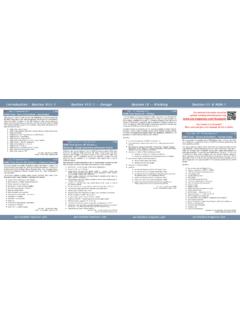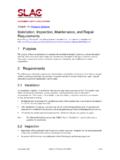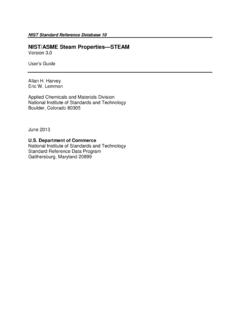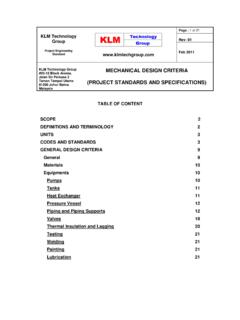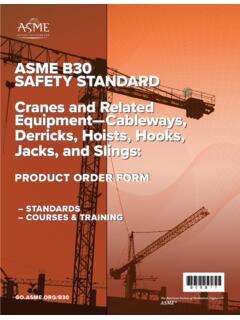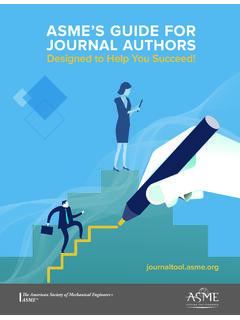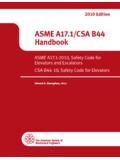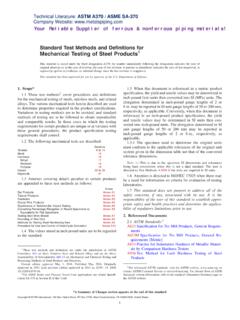Transcription of ASME Code and PED - The new Section VIII Division 2 ...
1 Presentation at 8th European Pressure Equipment Conference 25-26 June 2009, F rstenfeldbruck, Germany Page 1 asme Code and PED - The new Section VIII Division 2 - really everything new? Dr. Dirk K lbl, Essen 1. SummaryASME has published a completely rewritten Section VIII Division 2. Under the PED this Division evidences advantages compared to the preceding editions. Numerous changes have been compiled to a modern pres-sure vessel Code, which has the potential for an international best-seller. Compliance with PED is not guaran-teed, but made easier than in the past. Now it is up to the users to vote for the success of the new Division 2. Code and PEDASME Boiler and Pressure Vessel Code, published by the american society of mechanical Engineers, is frequently used to fulfil the European Pressure Equipment Directive (PED). Not much in Germany, however in the south of the EU, and even more in the Middle East and overseas asme Code is the most frequently used Code for pressure equip-ment.
2 Manufacturers, Contractors, Engineering companies and Owners of pressure equipment like to specify asme Code, and often use this well known Code also under the PED. Comparison of asme and PED, although pub-lished in many occasions, are not really appropri-ate. The PED is a regulation at the location of in-stallation, and enforced by laws in the entire EU. asme Code on the other hand is a technical standard in this context. It is not enforced by law in the EU, and used for the technical details of the design and fabrication of pressure equipment. To comply with the PED, Guideline 9/6 can be used as a help for the manufacturer to prepare his design package and to perform the hazard analysis as required by the PED. All Essential Safety Re-quirements published in Annex 1 of the PED shall be met. Annex 1 Chapter 1 through 6 are compulsory while chapter 7 requirements, if not met, may be re-placed by evidence that appropriate measures have been taken to achieve an equivalent overall level of safe-ty.
3 The evaluation shall be documented by the manufacturer in the design package, which will be submitted to the Notified Body for approval in cas-es where the chosen conformity assessment mod-ule specifies this. All Codes, specifications, and standards, when used should be used entirely. Cherry picking is certainly not recommended. Section VIIIS ection VIII comprises of three Divisions. Division 1 is the most commonly used Code for Pressure Vessels all over the world. Division 2, written for Engineered Pressure Vessels shows a much more sophisticated design approach. It contains methods for stress analysis, fatigue and creep analysis, combined with a sophisticated scope of non-destructive examination and amplified re-quirements on fabrication and material control. The more complex design approach requires certifica-tion by an experienced Professional engineer (RPE). The specific efforts to meet all the addition-al requirements is compensated by a higher utilisa-tion of material strength to carry stresses.
4 The use of Section VIII Division 2 is suitable in cases where the saved material could compensate the additional efforts, or when the purchaser of the vessel specifies Division 2. Section VIII Division 3 was first published in 1997. It specifically addresses pressure vessels designed for high pressures exceeding 70 MPa. new Section VIII Division 2On July 1st, 2007 the 2007 Edition of the asme Code was published, including Section VIII Div. 2, which was completely re-written. A new book. For all pressure vessels contracted for after Jan 1st, 2008 the new rules are mandatory, except when Code Case 2575 is specified. This case extends the transition period until June 30th, 2009. The new Division 2 was developed in a completely new structure: PART 1 - GENERAL REQUIREMENTS PART 2 - RESPONSIBILITIES AND DUTIES PART 3 - MATERIALS REQUIREMENTS PART 4 - DESIGN BY RULE REQUIREMENTS PART 5 - DESIGN BY ANALYSIS REQUIREMENTS PART 6 - FABRICATION REQUIREMENTS PART 7 - INSPECTION AND EXAMINATION REQUIREMENTS PART 8 - PRESSURE TESTING REQUIREMENTS Presentation at 8th European Pressure Equipment Conference 25-26 June 2009, F rstenfeldbruck, Germany Page 2 PART 9 - PRESSURE VESSEL OVERPRESSURE PROTECTION Nine parts are addressing the key aspects of pres-sure vessel construction.
5 Additional requirements are specified in Normative Annexes to the parts. Guidance and information is attached in Informa-tive Annexes. Not only the structure is new, also the technical contents and numerous details have been changed significantly. The result is a real new Code for pressure vessels. Many of the changes are an-swering demands arising from international users. The Design Specification and the Design Report for example may be certified by an RPE or by an-other competent, and experienced person ac-ceptable to the authorities at the location of instal-lation. A change that was requested by the industry for many years. The design approach was revised completely. Now Design by Formula is not more mandatory when Design by Analysis is performed. In the design rules, the use of computers has been considered, the method for stress analysis and even the criteria for establishing allowable design stress values were changed. Even more changes were planned and may be expected in the upcoming Editions and Addenda.
6 The non-destructive examination was revised to re-flect examination groups and allowing spot-examination, all quite similar to EN 13445. Even material toughness requirements and the hydro-static test pressure were changed to the values specified in the PED. Consequently some, but not all discrepancies to the PED in technical details were eliminated, which will make it easier to fulfil PED with a Divi-sion 2 vessel. Some requirements of the PED are still not met by Division 2. The required Hazard Analysis, Particular Material Appraisals for asme material, material certification ( ), approval of Welding procedures and personnel qualification by the Notified Body are still unanswered by Division 2, just to mention the major topics. 5. Experience The past ten years have proven that asme Code may well be used by contractors and manufactur-ers to demonstrate compliance to the PED. Difficulties have been detected in many areas, and further problems will be to show in the future.
7 The most critical areas are: - Mixing of Codes (where interfaces are defined improperly, or conflicts are not considered) - Incompetent manufacturers, contractors, engi-neers, inspectors - Material certification - Differences in safety culture - Incomplete or inadequate specifications for pressure equipment The new Section VIII Division 2 will not solve all of these problems, but it will be easier to use in the PED environment than preceding editions. The first year of experience with the new Division 2 has shown some manufacturers joyfully working in the new environment, some carefully stepping ahead with proven design under the new rules, and some anxiously awaiting the next specification, and afraid to open the new book. The coming years will show how the new asme approach will prove it s standing in the international engineering world and how it will evolve further on. D. K lbl: asme Code and PED, New Section VIII Div. 2, Munich 20091 Druckger terichtlinie und asme CodeVerordnung am AufstellortTechnisches RegelwerkVergleichbar?
8 Anwenden des asme Code mit PED Pr fen ob das Regelwerk die grundlegenden Anforderungen(Anhang 1) erf llt, wenn nicht, zus tzliche Anforderungen zum Regelwerk festlegen! Das Regelwerk m glichst als Gesamtheit anwenden(Leitlinie 9/6) do not cherry pick! Falls die besonderen quantitativen Anforderungen, Abs. 7 vomRegelwerk nicht erf llt werden, ist ein gleichwertigesGesamtsicherheitsniveau nachzuweisen Anwenden eines Anerkannten Regelwerks allein f hrtnicht zur Konformit tsvermutung!!!! Die Bewertung MUSS dokumentiert werden! Anhang 1 Abs tze 1 bis 6 sind verbindlich!D. K lbl: asme Code and PED, New Section VIII Div. 2, Munich 20092 asme Code und PEDANHANG I Grundlegende (..) Druckger quantitative Anforderungen f r bestimmte Druckger teArtikel 3: (1) Die unter den Nummer , , und angef hrten Druckger te m ssen die in Anhang I genannten grundlegenden Anforderungen erf (0,315 ) Section VIII Division 1 bis 3,000 psi (20 MPa), dar ber besondere Anforderungen einfache Berechnungsmethoden keine Spannungsanalyse gefordert international weitverbreitete Anwendung f r Druckbeh lterSection VIII Division 2 Alternative Rules fr her.
9 Bis 10,000 psi (70 MPa) Design by Rule / Design by Analysis Betreiber mu Betriebsbedingungen festlegen (User s Design Specification) Hersteller mu Herstellungsbericht erstellen (Manufacturer s Design Report) UDS wird erstellt / MDR wird zertifiziert von bef higten Personen h here Festigkeitsausnutzung h here Anforderungen an die Fertigung / umfangreichere zerst rungsfreie Pr fung geringere Wandst rken sparen Kosten enth lt Kriterien f r die Bewertung der Spannungsanalyse, Erm dung, DauerfestigkeitSection VIII Division 3 ber 10,000 psi Spannungsanalyse ist gefordert vorgespannte Komponenten werden ber cksichtigt umfangreiche zerst rungsfreie Pr fung verpflichtend sehr eingeschr nkte Materialauswahl und Fertigung zwei Registered Professional Engineers sind gefordert asme Code Section 10-08D. K lbl: asme Code and PED, New Section VIII Div. 2, Munich 20093 NEU und KNACKIG!ALT UND VIII Division 2 Alte Ausgaben bis 2004 mit 2006 Addendabis 10,000 psi (70 MPa)Designgrundlagen aus den 1950er JahrenNicht f r Computereinsatz gemachtImmer: Design by Rule, zus tzlich Design by Analysis und Lastwechsel, AusnahmenBetreiber mu Betriebsbedingungen festlegen (User s Design Specification)Hersteller mu Entwurf erstellen (Manufacturer s Design Report)UDS und MDR werden zertifiziert von RPE (Registered Professional engineer )Besondere Anforderungen an Material, Fertigung, Pr fung, Abnahme, Dokumentation Section VIII Division 10-08 Ausgabe 2007 (und 2008 Addenda)Komplett neue erstelltes RegelwerkDesign by Rule, ODER Design by Analysis User s Design Specification und Manufacturer s Design Report genauer vorgegebenRPE (Registered Professional engineer ) oder Bef higte Person als Pr fer von UDS und MDRK omplett andere Festlegung der BerechnungsmethodeComputerfreundliche Grundlagen (Vision!)
10 Erh hte Ausnutzung der FestigkeitAnpassungen an EN 13445 und damit an die PEDO ptionen f r stichprobenbasierte Pr fung, UT statt : Modernes Weltklasseregelwerk f r hochwertige Druckbeh lterD. K lbl: asme Code and PED, New Section VIII Div. 2, Munich 01/2008 VIII-2 Code Case - Erscheinen der Edition 2007, mit der neuen Section VIII Division - Edition 2007 tritt in Kraft und l st die Edition 2004, Addenda 06 regul r ab. Als bergangsl sung kann per Code Case 2575 die alte Ausgabe noch weiter verwendet werden, wenn in der Design Specification f r den Auftrag vorgesehen. Ende der bergangsfrist nach Code Case 2575. Achtung: Es gilt das Datum des Auftrages! Altauftr ge m ssen nicht ge ndert werden. 01/2008 VIII-2 Code Case 2575D. K lbl: asme Code and PED, New Section VIII Div. 2, Munich 03-09 asme Code Section VIII, Division 2 Inhalt: PART 1- GENERAL REQUIREMENTS (Allgemeines)PART 2- RESPONSIBILITIES AND DUTIES (Verantwortlichkeiten)PART 3- MATERIALS REQUIREMENTS (Material)PART 4- DESIGN BY RULE REQUIREMENTS (Berechnungsformeln)PART 5- DESIGN BY ANALYSIS REQUIREMENTS (FEM Berechnungen)PART 6- FABRICATION REQUIREMENTS (Fertigung)PART 7- INSPECTION AND EXAMINATION REQUIREMENTS (Abnahme und Pr fungen)PART 8- PRESSURE TESTING REQUIREMENTS (Druckfestigkeitspr fung)PART 9- PRESSURE VESSEL OVERPRESSURE PROTECTION (Schutz gegen berdruck)Am Ende jedes Parts.
